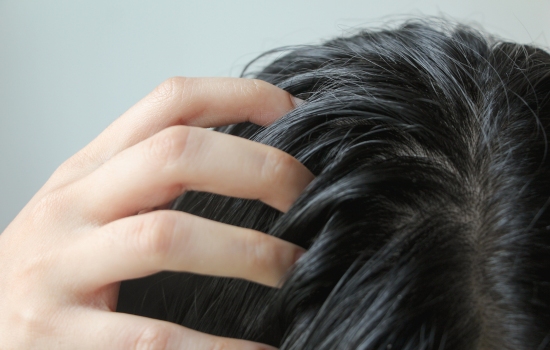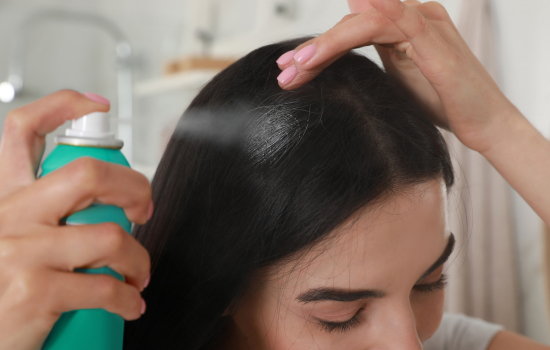
HOW TO MAKE YOUR HAIR LESS GREASY

Emma Justine Stylist
Greasy hair can be a real confidence dampener. Whether you’re battling oily hair due to your hair type, lifestyle, or other factors, there are effective ways to combat the grease and achieve fresher, healthier-looking locks. By following these tips suggested below, you can regain control over your hair’s oil production and maintain a clean and beautiful mane.
Foundations of Hair Care
Regular Hair Washing
When it comes to managing greasy hair, one of the most basic and essential steps is regular hair washing. The right washing routine can make a significant difference in controlling oiliness.
Use a mild, sulfate-free shampoo: Look for shampoos designed for oily hair. These are often labeled as “clarifying” or “oil-control” shampoos.
Lukewarm water: Opt for lukewarm water when washing your hair. Hot water can stimulate your scalp to produce more oil.
Don’t overwash: Washing your hair every day can strip your scalp of essential oils, leading to increased oil production. Aim to wash your hair every other day or as needed.

Choose the Best Shampoo
Selecting the right shampoo is crucial in the battle against greasy hair. Not all shampoos are created equal, and using the wrong one can exacerbate the issue.
Go for clarifying or oil-control shampoos: These shampoos are specifically formulated to remove excess oil and product buildup without drying out your hair.
Read labels: Look for keywords like “oil-free” or “non-comedogenic” on the shampoo bottle. These indicate that the product is less likely to contribute to greasiness
Try double cleanse with two shampoos: The first shampoo is for getting rid of all product and oil buildup, while the second one is for cleansing the scalp.
Keep Water Temperature in Check
The temperature of the water you use to wash your hair can affect your scalp’s oil production. Find out how to strike the right balance.
Opt for lukewarm water: Using hot water can stimulate your scalp’s oil glands, leading to more grease. Lukewarm or cool water is gentler on your scalp and helps maintain balanced oil production.
Condition with Care
Conditioner is an essential part of your hair care routine, but using it correctly can make a big difference in managing greasy hair.
Focus on the ends: Apply conditioner primarily to the ends of your hair, avoiding the scalp. This prevents adding excess oil to your roots.
Choose lightweight, oil-free conditioners: Look for conditioners that are specifically designed to be lightweight and free of heavy oils that can weigh down your hair.
Thorough Rinsing
Rinsing your hair and scalp thoroughly after shampooing and conditioning is essential to prevent product buildup that can contribute to greasiness.
Take your time: Spend a little extra time rinsing your hair to ensure that all shampoo and conditioner residue is thoroughly washed out. Inadequate rinsing can leave behind residue that makes your hair look greasier.
Styling and Maintenance Tips
Ease Up on Heat Styling
Heat styling tools like flat irons, curling irons, and blow dryers can make your hair appear oilier. Learn how to minimize the impact of heat styling on greasiness.
Limit heat styling: Reduce the frequency of using heat styling tools. Air drying your hair or using the lowest heat setting on your blow dryer can help.
Apply a heat protectant: Before using heat styling tools, always apply a heat protectant spray or serum to shield your hair from damage.

Embrace the Wide-Tooth Comb
Post-wash, how you handle your hair matters. Discover the benefits of using a wide-tooth comb.
Use a wide-tooth comb: After washing your hair, gently detangle it with a wide-tooth comb. This reduces friction and minimizes the spread of oil from your scalp to your hair.
Scalp Massages
Scalp massages aren’t just a luxurious treat; they can also help manage greasiness and promote hair health.
Use your fingertips: Gently massage your scalp with your fingertips in circular motions. This helps distribute natural oils more evenly across your scalp.
Promote blood circulation: Scalp massages boost blood circulation, which can enhance hair health and reduce oiliness.
Dry Shampoo to the Rescue
Dry shampoo is a game-changer for greasy hair. Learn how to use it effectively between washes.
Apply at the roots: Spritz dry shampoo at the roots of your hair, focusing on areas that tend to get greasiest.
Massage and brush: After applying dry shampoo, massage it into your scalp, and then brush through your hair to distribute it evenly.
Hands Off Your Hair
Your hands can transfer natural oils and dirt to your hair throughout the day, making it greasier. Discover why it’s essential to keep your hands off your locks.
Break the habit: Make a conscious effort to avoid touching your hair throughout the day, especially if your hands aren’t clean.
Choose the Right Hair Products
The products you use on your hair can either contribute to or help combat greasiness. Learn how to make informed choices.
Look for “oil-free” or “non-comedogenic” products: When shopping for hair products, check the labels for these keywords. They indicate that the product is less likely to add to your hair’s greasiness.
Regular Haircuts
Even if you’re not looking for a major style change, regular trims can help manage excess weight and oil buildup in your hair.
Schedule regular trims: Visit your hairstylist for trims every few weeks or months, depending on your hair’s needs. Removing split ends and excess weight can make your hair appear less greasy.
Dietary Habits for Healthy Hair
Balanced Diet
The food you consume has a direct impact on your hair’s health, including oil production. Discover how to optimize your diet for less greasy hair.
Eat a well-rounded diet: Consume foods rich in vitamins, minerals, and antioxidants. Omega-3 fatty acids found in fish, flaxseeds, and walnuts can help regulate oil production.
Hydration
Staying hydrated is not just essential for your overall health but also for your hair. Learn how proper hydration can help balance oil production.
Drink enough water: Aim to drink the recommended daily amount of water to stay well-hydrated. This can help regulate oil production in your scalp.

Limit Junk Food
Processed and fried foods high in sugar and unhealthy fats can exacerbate scalp oiliness. Find out how to reduce their impact on your hair.
Cut back on junk food: Reduce your consumption of processed and fried foods to help your hair stay less greasy.
Manage Stress
Stress can trigger your scalp to produce more oil. Explore stress management techniques to keep your scalp calm and your hair less greasy.
Practice stress reduction: Incorporate stress-management techniques such as meditation, yoga, deep breathing exercises, or even a relaxing hobby into your routine.
Say Goodbye to Grease
Greasy hair is a common issue, but it’s one that you can effectively manage with the right techniques and lifestyle changes. Experiment with these tips to find the combination that works best for you. Remember that it may take some time to see noticeable improvements, so be patient and consistent in your efforts. With dedication and the right approach, you can enjoy hair that looks fresh, clean, and less greasy.
The journey to less greasy hair begins with small changes and a commitment to healthier hair care habits. By incorporating these strategies into your daily routine and embracing a balanced lifestyle, you can achieve the vibrant, non-greasy hair you’ve always dreamed of. So, go ahead, try out these tips, and unveil the beauty of your hair with confidence!
With the proper knowledge and dedication, you can transform your greasy hair into healthy, gorgeous locks that shine with vitality.